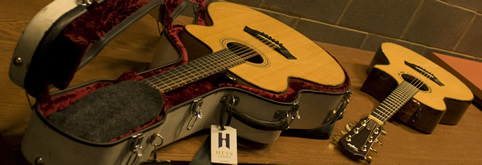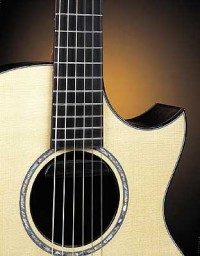Favorite Guitars and Gear
Quick 2018 News Flash- Chris’s CPSM, and his GC Custom, both detailed below, are back from the Taylor factory after getting the newest Expression System retrofit and Taylor Service’s usual stellar fretwork and cleanup. The newest ES is definltely improved sonically, with more detailed high frequency woodiness and clarity. Three other studio guitars have received doses of Taylor love over the last several months as well. A special shout-out to Tim Luranc, his favorite repair tech and old buddy, as he retires and begins to explore life away from the tech bench.

With the creation of the Chris Proctor Signature Model (CPSM) in the fall of 2000, Chris had a new dream guitar. Here are some of its unique features:
- A wide 1 7/8″ neck
- AAA Indian Rosewood body and AAA Englemann Spruce top
- The CPSM had a unique pickup system when it was first built, but it has been retrofitted with Taylor’s Expression System as of January 2004.
- A rosewood bridgeplate
- Jumbo position dots for better performer’s visibility of the neck and fingering position
- Ebony tuning pegs and an exquisite abalone rosette, which set off the otherwise plain and beautiful woods and binding

A new custom 12-string with the new Taylor ES pickup system arrived a couple of years later, and became Chris’ touring 12-string. The guitar was built along the lines of the LKSM, sporting its unique Sitka spruce top bracing for the “Heavy and Low” string and tuning approach which Chris favors, and the general LKSM design aesthetic, but with two significant departures- it was built of Bigleaf Maple, and has a maple neck as well. In a sense it splits the difference between his two favorite 12-strings, the old maple 955 and the newer LKSM. The Expression System adds another layer of difference of course, and concert and workshop attendees are now able to see and hear it when Chris performs in concert, and can also hear it on four cuts of “The Chris Proctor Collection,” and one cut of the brand new “Ladybug Stomp.”
Chris is also touring with a new Taylor Grand Concert, made with Brazilian Rosewood sides and back and Englemann Spruce top, and sporting all of Taylor’s 30th Anniversary design changes, along with several custom features. These include:
- A wide 1 7/8″ neck
- Florentine cutaway
- Forward-shifted bracing
- 1/4″ deeper body, and rebraced and revoiced top, with Taylor’s innovative new edge-thinning along its perimeter
- 24 7/8″ scale length, slightly shorter than the old standard of 25 3/8″
- Abalone sound hole rosette and body trim and larger position dots ala the CPSM
- ES amplification system
Two other remarkable guitars are also among Chris’ favorites, though they have largely become studio instruments and very seldom make it on his tours:
- A 1986 Taylor 912C Brazilian Rosewood 6-string
- A 1989 955C 12-string with German Maple back and sides and maple neck
Both instruments have lots of custom features, such as 1 7/8″ neck on the 6-string, laminated peghead veneers on both, extra wood binding trim and abalone inlays, a 3-piece back on the 6-string, maple three-piece neck on the 12-string, and both have dual pickup systems that Chris installed after their acquisition.
Other cool guitars include a 1984 K12C, (the very first Taylor Grand Concert) which can be seen in the new coffee table book about Taylor Guitars written by Michael John Simmons), an old 512C that was built from what remained after UPS had damaged two individual guitar, crushing the body of one and the neck of another, and a great 912 C from 1993 that was Chris’ main road guitar for 7 years prior to the coming of the CPSM. All of these have his preferred 1 7/8″ necks.
The 12-strings are re-tuned a whole step low, then re-tuned again into various open tunings. The result is a fat, less bright and very powerful sound that generally rivets the audience when Chris picks up the 12-string. From low to high, the strings are gauged as follows: .036/.058; .023/.045; .012/.035; .010/.025; .017 on the B strings and .013 on the E’s. Please note: This string gauge choice is only safe with lowered tunings as detailed above.
Chris’ 6-strings all are strung with custom-gauged strings. This set, developed by Chris a few years ago, is intended for folks who re-tune their instruments down into tunings like DADGAD, and features three strings from a normal medium set- .013/1st, .017/2nd and .056/6th, while the other three strings are from a normal light-gauge set- .024/3rd, .032/4th and .042/5th. The idea is to keep the string tension appropriate to the instrument, and as most strings are tuned lower in alternate tunings, as in DADGAD, with 1st, 2nd and 6th being taken down a whole step, those strings should have slightly meatier gauges. It isn’t perfect, but it seems to be the best compromise for those who travel with one instrument and lots of mostly lower tunings. GHS makes exactly this gauge, calling it “True Medium,” and offers both a Phosphor Bronze formulation and another alloy preferred by Laurence Juber. Try TM335, the Phosphor Bronze set, which you can find at stores, or at this GHS link.
Chris uses Alaska Piks. Please check their site, www.alaskapik.com, for more information and for availability information. The quick detail about the Alaska Pik is this- they replace your natural nail with a plastic one which inserts between your nail and the tip of your finger. Once you experiment and learn the four big secrets of their use (1- cut out their middle band; 2- cut them to the length and profile that works for you, and that imitates your perfect nail; 3- sand and buff all points of contact around the edges and sides of the picks to minimize the downside of their rubbing against each other when doing tremolo or i-m-i-m stuff; and 4- use a nail file to remove the corners of the nails from your three right hand fingers so that the picks will seat easily in the groove between your nail and the tip of your finger)
Chris uses both concave brass slides from Latch Lake, and also real bottleneck glass slides that are made by Rick Park. It just depends upon the desired sound- brass sustains more and has more bite, but glass is smoother and sweeter, and being lighter, is easier to control on the little finger.
Amplification Gear, Electronics, And Signal Path
With the coming of Taylor’s ES system, Chris’ former complicated approach to guitar amplification has been happily simplified. He is using the ES pickups with Taylor’s K-4 preamp for bringing his guitar sound into the amplified world.
Chris plugs his balanced ES guitar outputs, from both 6 and 12-string guitars, into the TRS input of the K4, then sends the balanced, line-level output from the K-4. A foot-controlled Roland SE-70 multi-effects unit, which he uses for reverbs and other effects, is inserted into the effects loop of the K-4. The effects are used in a generally dry and subtle manner save for the occasional long echo which he uses with the E-Bow.
For trips where luggage space is crucial, Chris uses a Zoom A2 multieffects pedal, inserted via the effects loop into a Baggs Paracoustic DI. This allows him to fit all gear and cords into the accessory space in his guitar case, and makes flying a lot easier in these days of increasing penalties for luggage, surly airlines employees and TSA goofballs.
